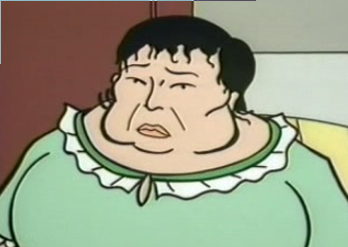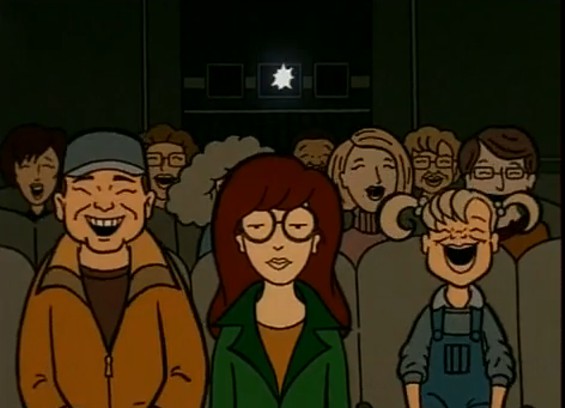Fat, Black, and Desirable: Fat Positivity and Black Women by Chantell Monique
If these women aren’t seeing any positive images of themselves on screen, how are they able to construct an identity of truth? Even though they can rely on their community for positivity, if it’s not reinforced through media representation then it renders that support useless.
Invisible Fat Women on How I Met Your Mother and The Big Bang Theory by Stephanie Brown
Several sitcoms, however, rely not on the on-screen presence of a so-called “unruly body,” but rather on the imagined image on an off-screen one.
Fatphobia: What Daria Got Wrong by Maggie Slutzker
She tells the girls she isn’t supposed to eat chocolate, but she’d like to buy some anyway. Then, she faints as a result of hypoglycemia and possibly exhaustion, the results of her being so large. Daria and Jane stand still for a moment, startled and clueless, and then Jane takes a picture.
Steven Universe: Many Dimensions of Fat Positivity by Stella DellaRosa
He is soft. He is round. He is squishy and loving and completely without pretense. There is no guarding wall around his heart, no desire to compete with other boys, no need to be seen as “cool” or “tough” or “edgy,” and no compulsion to become anything other than what he already is because he knows that “what he already is” has value.
What They Did Right in The Heat by Rhea Daniel
Her character may at first feed the stereotype that fat people are overbearing, belligerent and take up too much space, but the camera doesn’t make her body a joke (with accompanying thunder-thighs music). I like M.I.A.’s “Bad Girls” as the song of choice, and they do look pretty believably badass, with a comic overtone.
16 and Healthy: My Mad Fat Diary Is Teen Girl Fat Positivity Gold by Ariana DiValentino
And therein lies what makes the show such a wonderful example of fat positivity and feminism—Rae is, per her own description, mad and fat, but it takes less than a single episode to make it abundantly clear that she is so much more than that.
Parks and Recreation: How Fatphobia Is Invisible by Ali Thompson
I don’t think it would be quite the same barrel of laughs if the motto of Pawnee were “First in Friendship, Fourth in Poverty.” Fat shaming and fat jokes like the People of Walmart photos are often a socially acceptable stand-in for the classist shaming of poor people. Poor people are more likely to be fat, after all. We get paid less and we’re more likely to be fired. Oh, the comedy!
Shallow Hal: The Unexpected Virtue of Mockery by Brigit McCone
Its challenge to fatphobia is covered in fat jokes and gross-out humor, tailored to trigger our prejudices. We can laugh, if prepared to question why. We can sympathize, if braced against an awkwardly half-choked, giggling snort. Humor strikes faster than self-censorship.
When Being Fat Isn’t A Big Deal: Jenny Gross on Winners and Losers by Ren Jender
The default body size also extends to actresses who are not meant to be “decorative.” In writer-director Andrea Arnold’s powerful, excellent Red Road, from the UK, star Kate Dickie has a nude scene which is neither meant to be nor is erotic, but her body has as little fat as that of a professional marathon runner. When women see these bodies as “the norm” in films and TV even those of us fortunate enough not to hate our bodies (and even those of us who are not habitually called slurs because of our size) have to fight against the tendency to ask, “What exactly did my body do wrong to be so unlike that of nearly every woman I see onscreen?”
The Foxy Merkins and the Uncharted Territory of the Fat, Lesbian Protagonist by Tessa Racked
That separation is reinforced by much of the film’s comedy, but Margaret isn’t positioned as an object of ridicule or disgust, as is often the case with fat and/or gender non-conforming characters. She is naive, gauche, and in over her head, but she is also the character with whom the audience empathizes most.
The Revolutionary Fatness of Steven Universe by Deborah Pless
It does my heart a lot of good to watch this show and imagine a world where no one gives two craps about my weight. But I can only dream of how much this must mean to the little kids watching it. I mean, bear in mind, this is a children’s show. It is meant to be consumed by children. And those children will be watching the wacky adventures, thinking to themselves, “These heroes look like me. That means I could be a hero too!”
The Fat Stardom of James Gandolfini by Sarah Smyth
What’s clear is that, in our contemporary society and culture, the male body is not invisible. Although the female body continues to be more heavily regulated and controlled, particularly in terms of weight and appearance, the male body is no longer removed from similar considerations. As we continue to look more intensely and critically at the male body, we can anticipate a time when new images of masculinity become not only realized but embodied.
Sophie in Don Bluth’s Anastasia by Jackson Adler
Sophie is still exceptional among animated characters, and even live action characters. Though a fantastic character, she should not be the exception. She should not be a rare case of fat-acceptance. It should not be rare that a fat woman loves herself and is loved.
Geraldine Granger, the Vicar at Large: Fat Positivity in The Vicar of Dibley by Rachel Wortherley
Because of their position in the church as a figure that facilitates human connection to a higher power, people usually disconnect priest, vicars, etc. from human emotions. Being sexless or promiscuous is also attributed to female characters in media who are fat, or overweight…One of the exciting things about The Vicar of Dibley is that Geraldine is not a sexless and humorless character—as a vicar and a woman with a fat body.
What Your Doctors Really Think About You: Fatphobia on Medical TV by Elizabeth Kiy
Fat bodies have a curious position in medical drama, reflecting the fatphobia existing within the medical profession. Doctors tend to assume weight always a cause rather than a symptom and overweight patients are either lazy, uneducated or poor. The wealthier we are, the more opportunity we have to strive for thinness. As a class, doctors are incredibly privileged, both highly educated and wealthy, they have the privilege of deciding to be thin that many of their patients do not.














